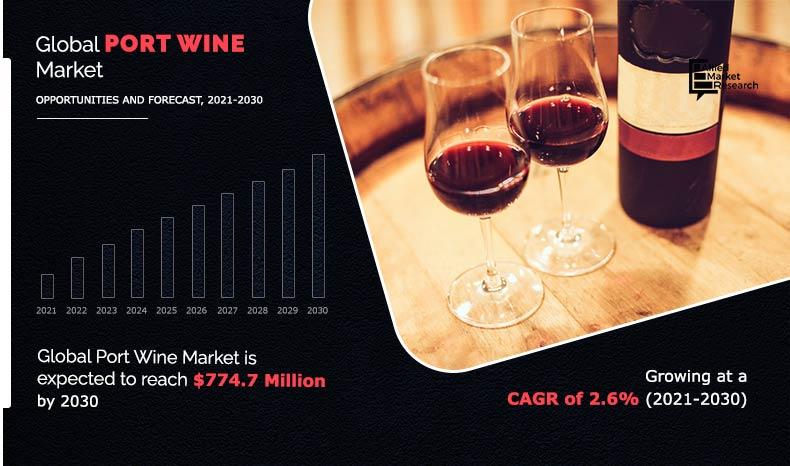Port Wine Market Research, 2030
The global port wine market was valued at $780.2 million in 2020, and is projected reach $774.7 million by 2030, registering a CAGR of 2.6% from 2021 to 2030.
Port wine is a fortified wine from Portugal’s Douro Valley, recognized for its rich flavors and sweetness. It is produced by fermenting grapes and adding grape spirit to halt fermentation, preserving natural sugars and increasing alcohol content. The wine is aged in barrels or bottles, which allows it to develop complex characteristics. Tawny and Ruby Ports should be stored upright, whereas Vintage Port is best kept horizontally. Once opened, Tawny retains its quality longer than Ruby or Vintage. It is commonly served as a dessert wine, complements cheese and chocolate, and improves sauces, reductions, and cocktails.
Market Dynamics
The growth in consumer preference for premium and fortified wines has driven demand in the global port wine market. Many consumers are seeking high-quality wines with rich flavors and strong aging potential, which has made port wine an attractive choice. The shift toward premium wines, particularly among collectors and wine enthusiasts, has increased demand for aged Tawny, Vintage, and special edition Ports. Interest in wine culture, fine dining, and gourmet pairings has contributed to higher consumption, with port wine recognized for its depth and complexity. Fortified wines with higher alcohol content and extended shelf life have gained popularity in both established and emerging markets, thus driving port wine market growth.
Expanding global accessibility through specialized retail, e-commerce, and direct-to-consumer sales has further supported the market size. Consumers are purchasing more high-end fortified wines, leading to increased sales of premium port variants. Wineries have introduced limited releases and collector’s editions to meet demand for exclusive offerings. The growth in demand for well-crafted wines with distinctive characteristics continues to strengthen the port wine market share, positioning it as a preferred choice among those seeking high-quality options within the premium wine segment.
Moreover, the rise in demand for dessert wines in fine dining and celebrations has contributed to the growth of the global port wine market. Port wine, known for its rich sweetness and complex flavors, is widely favored as a complement to desserts, cheeses, and gourmet dishes. Fine dining establishments are incorporating more dessert wines into menus, offering port wine as a pairing option to create a well-balanced dining experience. Consumers seeking high-quality wines for special occasions are driving demand for Tawny, Ruby, and Vintage Ports, which has led to increased global market share. The preference for well-matched wine pairings in restaurants has led to increased sales of port wine.
In addition, celebrations and festive gatherings have also contributed to higher consumption. Weddings, holiday events, and milestone occasions often feature dessert wines, with port wine remaining a popular choice owing to its aging potential and depth of flavor. Gift packaging and limited-edition releases attract buyers selecting premium wine options suited for gifting and special events. With strong demand for port wine in fine dining and celebratory occasions, the port wine market is expected to expand its presence in the global market, strengthening its position among premium dessert wines.
However, competition from other fortified and dessert wines poses a restraint on the global market. Consumers have a wide range of alternatives, such as Sherry, Madeira, and Marsala, which offer similar fortified characteristics at varying price points and flavor profiles. These wines often target the same market segment and are gaining popularity owing to their distinct qualities. In addition, dessert wines such as Sauternes and Tokaji, which are also highly regarded for their sweetness and aging potential, provide strong competition for port wine. The availability of such alternatives gives consumers more choices, leading to divided attention and, in some cases, limiting the port wine market growth in both traditional and emerging markets. Price sensitivity and regional preferences further influence consumer purchasing decisions, hindering the ability of global port wine industry to maintain its position as the dominant segment in the global market.
Along with other such restraints, stringent regulations on alcohol advertising and sales creates a barrier for the global market growth. Stringent regulations on alcohol advertising and sales further restrict the market growth. Many countries, such as the U.S., the European Union, India, Saudi Arabia, UAE, Australia, and Canada, enforce strict laws around alcohol marketing, which limits the ability to reach potential consumers through traditional advertising channels such as TV, radio, and digital platforms. Regulations often include restrictions on promotions, labeling, and sponsorships, which can hinder the visibility of port wine in key markets. Moreover, varying legal frameworks across regions create complexities for global distribution, affecting where port wine can be sold. Restrictions on alcohol promotion reduce consumer awareness and engagement, limiting port wine exposure to new customers. In markets with high alcohol consumption regulations, the ability to promote port wine is constrained, slowing growth of global port wine market size and reducing efforts to attract new buyers.
Furthermore, innovation in aging techniques and new flavor profiles is creating significant global opportunities. As consumer preferences shift toward unique and complex wines, winemakers are experimenting with different aging processes to develop new characteristics. Innovations such as the use of alternative barrels, including oak from various regions, or aging in smaller containers, allow port wine to acquire distinct flavors not traditionally associated with classic aging methods. Advancements in the aging process have potential to attract wine consumers seeking diverse options and helping port wine maintain relevance in a competitive market.
Similarly, the development of new flavor profiles has attracted a wider audience in recent years. Winemakers are blending traditional port varieties with innovative techniques, incorporating fruit-forward or spicy notes, and adjusting sweetness levels to meet evolving tastes. Limited-edition releases and experimental aging practices are becoming more common, offering consumers exclusive wine experiences. Innovation in aging techniques and flavor profiles is helping port wine manufacturers enter new markets where consumers are more willing to try novel products. Thus, such advancements are positioning and helping in expansion of global port wine market share.
Segment Overview
The global port wine market segmentation is done on the basis of type, price point, sales channel, and region. By type, the market is bifurcated into tawny and ruby ports. By price point, the market is bifurcated into premium and mass. By sales channel, the market is studied across on trade and off trade. By region, the market is analyzed studied across North America, Europe, Asia-Pacific, and LAMEA.
By Type
Based on type, the tawny segment dominated the global market size in 2020 and is anticipated to maintain its dominance during the forecast period owing to the shift in consumer preferences toward aged and refined wines. Extended barrel aging improves its flavors, developing notes of caramel, dried fruit, and nuts, which attract those seeking smooth and well-matured options. A wide range of ageing categories, from 10 to 40 years, strengthens its position across various price points, appealing to both casual buyers and collectors, leading to an increase in the global market. Rise in demand for premium and collectible wines has further contributed to its expansion, as it is often positioned as a high-end choice within fortified varieties. Expanding international distribution, particularly in North America and Europe, has strengthened its presence in key markets. Thus, strong sales from fine dining establishments and the gifting segment continue to drive its growth, ensuring its influence on global port wine market trends.
By Type
Tawny segment would exhibit the highest CAGR of 2.8% during 2021-2030.
By Price Point
By price point, mass segment dominated the global market in 2020 and is anticipated to maintain its dominance during the forecast period owing to strong global port wine market demand for affordable and accessible wines. Competitive pricing attracts a broad customer base, including casual drinkers and those new to fortified wines. Supermarkets, convenience stores, and online platforms have expanded availability, driving higher sales in the global port wine market. In addition, global market opportunities are growing as wineries introduce value-focused offerings while maintaining quality to meet evolving consumer preferences. Emerging markets, particularly in Asia and Latin America, are contributing to increased sales, with affordability remaining a key purchasing factor. Global market analysis indicates that the expanding influence of online retail and direct-to-consumer sales will further strengthen the mass segment, ensuring its continued dominance as consumers seek budget-friendly options.
By Price Point
Premium segment would exhibit the highest CAGR of 3.3% during 2021-2030.
By Sales Channel
Based on sales channel, the off trade segment dominated the global port wine market size in 2020 and is anticipated to maintain its dominance during the forecast period. Increase in demand for retail convenience, including supermarkets, liquor stores, and online platforms, has fueled growth in this segment. Consumers prefer purchasing port wine for at-home consumption, aided by the availability of various packaging sizes and promotional offers. The expansion of online retail has contributed to reaching a broader audience, that allows customers to explore and purchase a wide range of port wines from the comfort of their homes. With rise in disposable incomes and changing lifestyles in emerging markets, the off-trade segment is poised for sustained growth in the coming years. Furthermore, the global market forecast suggests that continued investments in retail and e-commerce platforms will further strengthen this segment growth. Increased availability and competitive pricing have made the off-trade channel an essential factor in driving the growth of the global port wine industry.
By Sales Channel
On Trade segment would exhibit the highest CAGR of 3.0% during 2021-2030.
By region
Region-wise, Asia-Pacific is anticipated to grow at the fastest CAGR during the forecast period. The growth of interest in wine culture, particularly in countries such as China, India, and Japan, is contributing to the rapid expansion of port wine in global market. The rise in e-commerce and organized retail in emerging markets has increased access to port wine, driving higher sales. In addition, a younger consumer base has reflected more interest in exploring wine consumption. With greater awareness of fortified wines and global wine trends spreading across the region, Asia-Pacific presents significant growth opportunities for the port wine market.
By Region
Asia-Pacific region would exhibit the highest CAGR of 5.6% during 2021-2030.
The report focuses on the market growth prospects, restraints, and opportunities. The study provides Porter’s five forces analysis to understand the impact of various factors such as competitive intensity of competitors, bargaining power of suppliers, threat of substitutes, threat of new entrants, and bargaining power of buyers of the port wine market.
Competition Analysis
Some of the major players profiled for in the port wine market analysis include Adriano Ramos Pinto, Calabria Family Wines, Davy & Co Limited, Grupo Sogevinus Fine Wines, Precept Wine, Quevedo, Quinta do Crasto, Sula Vineyards, Symington Family Estates, and The Fladgate Partnership. Other prominent players analyzed in the report are Contratto, Albina& Hanna, Sogevinus Fine Wines SL, Liberty Wines Limited, Offley, Forrester & Weber, Martinez Gassiot, Vinhos SA, C N Kopke Wineries, and AA Calem.
Key Benefits For Stakeholders
The report provides an extensive analysis of the current and emerging market trends and opportunities.
The report provides detailed qualitative and quantitative analysis of the current trends and future estimations that help evaluate the prevailing port wine market opportunities in the market.
The port wine market forecast is offered along with information related to key drivers, restraints, and opportunities.
The market analysis is conducted by following key product positioning and monitoring the top competitors within the market framework.
The report provides extensive qualitative insights on the potential and niche segments or regions exhibiting favorable growth.
Port Wine Market Report Highlights
| Aspects | Details |
| By Type |
|
| By Price Point |
|
| By Sales Channel |
|
| By Region |
|
| Key Market Players | SULA VINEYARD, GRUPO SOGEVINUS FINE WINES, QUINTA DO CRASTO, SYMINGTON FAMILY ESTATES, QUEVEDO, CALABRIA FAMILY WINES, ADRIANO RAMOS PINTO, DAVY & CO LIMITED, PRECEPT WINE, THE FLADGATE PARTNERSHIP |
Analyst Review
Recent trends in the past few years have seen an increase in alcohol consumption. Especially as a hobby or as a source of entertainment or socialization. A lot of the newer alcohol drinkers prefer spirits or wines that are sweeter and easier to drink, as they can find heavier or darker spirits unpleasant and intense. This boosts the preference towards port wines.
Port wine is made in a few countries, however, only the port wine made in the Douro valley of Portugal is considered to be authentic port, or porto wine. These wines are made traditionally through many years using same or similar techniques to maintain consistency in quality and taste of the wine. Because of its sweet flavor, it is mostly consumed after dinner as a desert wine or a digestive wine. Most of the aficionados or connoisseurs of port wines prefer tawny ports due to their flavor complexity and aging process, while newer drinkers are more attuned to ruby port and cocktails like port and tonic.
Adoption of omnichannel approach of selling port wine by engaged stakeholders is helping to increase the reach of the wine to countries that may not still be adoptive or appreciative of port wines. This is also contributing to awareness regarding port wines, especially with winery tours for tourists in the region producing the wines, and it will help the port wine market to reach newer avenues.
The port wine market is expected to reach $774.7 million by 2030.
The port wine market is poised to grow with a CAGR of 2.6% from 2021 to 2030.
Kindly raise an inquiry through the chat box and our business executive will get in touch with you with the details on the purchase options.
The forecast period for the market report is 2021-2030
the segments of the port wine market are determined by the type, price point, and sales channel.
Organic port wine, wine fortification and emergence of online sales channels are the trends likely to shape global market in future.
Some of the major players operating in the port wine market are Adriano Ramos Pinto, Calabria Family Wines, Davy & Co Limited, Grupo Sogevinus Fine Wines, Precept Wine, Quevedo, Quinta do Crasto
By region, the Europe segment will dominate the market by the end of 2030
The covid -19 pandemic will negatively impact the global market.
Loading Table Of Content...



